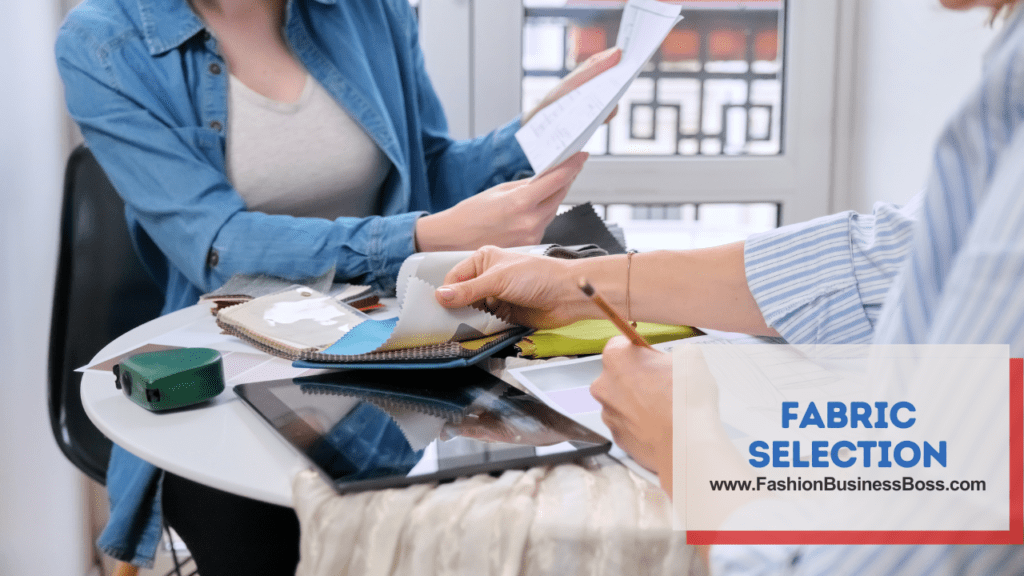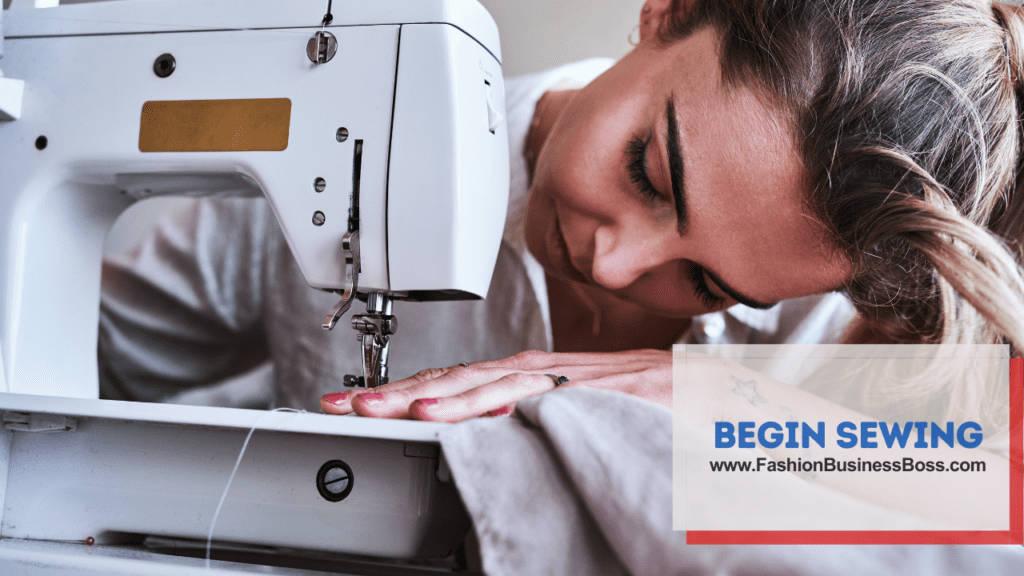Designing clothes is an art form that allows you to express your creativity and style while crafting unique pieces that stand out in the world of fashion. Whether you’re an aspiring designer or just someone passionate about fashion, this guide will walk you through the process of starting your clothing design journey.
To embark on your clothing design journey, start by defining your unique style and gathering inspiration. Learn sewing basics, choose the right fabrics, sketch your designs, and practice patience in the sewing process.
In this article, let’s dive into the world of fabric, stitches, and endless possibilities.
Define Your Style

Creating clothing designs begins with a clear understanding of your personal style. To embark on this journey, start by identifying what inspires you and the type of clothing you aim to craft. Are you drawn to casual, formal, or avant-garde fashion?
Your style is essentially the core element that underpins all your design choices. It’s the compass guiding you as you navigate the world of clothing design. By defining your style, you establish a solid foundation for your creative process.
Consider your sources of inspiration. Do you find yourself inspired by nature, architecture, or perhaps historical fashion eras? Understanding these influences can help you narrow down your style preferences. It’s essential to keep it simple and clear, making sure your style resonates with you and aligns with the vision you have for your clothing creations.
So, remember, at the outset of your clothing design journey, take time to define your style. This initial step will serve as the cornerstone upon which you’ll build your unique and appealing clothing designs.
Read more about: Establish Your Brand and Put a Label on Your Wholesale Clothing With These 8 Easy Steps
Gather Inspiration
Gathering inspiration is a fundamental aspect of clothing design. Fashion designers draw ideas from various sources in their surroundings. Pay close attention to what’s happening in the fashion world, observe art, nature, and even everyday occurrences.
One useful technique is to assemble a mood board. A mood board is like a visual collage that captures the essence of your creative vision. It can include images, colors, and textures that resonate with the style you want to convey in your designs.
Start by exploring fashion trends in magazines, online platforms, or by observing people’s clothing choices in your daily life. Take note of what catches your eye and aligns with your design goals. Immerse yourself in the world of art and nature, as these can be rich sources of inspiration.
Collect images, swatches of fabric, or even photographs that evoke the feelings and ideas you wish to express in your clothing designs. The process of creating a mood board can help clarify your vision and provide a visual reference point as you embark on your design journey.
Gathering inspiration involves keeping a keen eye on the world around you and organizing your creative ideas through a mood board. This step sets the stage for translating your vision into tangible clothing designs.
Learn the Basics of Sewing
Acquiring a solid grasp of the basics of sewing is essential for a clothing designer. This foundational knowledge is the cornerstone of transforming your design ideas into tangible garments.
To begin, consider investing in a reliable sewing machine. It will be your primary tool in the clothing design process. Familiarize yourself with the machine’s functions and how to operate it effectively.
Next, take the time to learn various sewing stitches. These stitches serve as the building blocks of garment construction. Understanding when and how to use different stitches is vital for ensuring the durability and quality of your creations.
Practice is key in this endeavor. Start by working with fabric scraps. This hands-on experience will help you refine your sewing skills and gain confidence in handling different materials. It’s a gradual process, so be patient with yourself and embrace the learning journey.
Mastering the basics of sewing is a crucial step for any clothing designer. By investing in a sewing machine, learning various stitches, and practicing on fabric scraps, you pave the way to bringing your design concepts to life in a tangible and skillfully crafted manner.
Fabric Selection

The process of selecting the appropriate fabric for your clothing designs is a critical decision that can significantly impact the outcome of your creations.
When making this choice, it’s important to take several factors into account. These include the texture, weight, and durability of the fabric. Each of these aspects plays a vital role in determining how the finished garment will look, feel, and perform.
Texture refers to the tactile qualities of the fabric. It can range from smooth and silky to rough and coarse. The choice of texture should align with the aesthetic and comfort level you aim to achieve in your designs.
Weight pertains to how heavy or light the fabric is. Heavier fabrics are more suitable for structured garments, while lighter ones work well for flowing or delicate styles. Your design vision will guide you in selecting the appropriate weight.
Durability is essential to ensure that your creations stand the test of time. Consider the intended use of the garment and choose a fabric that can withstand the wear and tear associated with its purpose.
To make informed fabric choices, take the time to study various fabrics, their properties, and how they drape when worn. This knowledge will empower you to select the right materials that align with your design goals and bring your clothing visions to reality.
Read more about: Embark on Your Fashion Journey: Your Roadmap to Launching a Clothing Line
Sketch Your Designs
The practice of sketching your clothing designs is a crucial step in the creative process. Even if you don’t consider yourself an artist, these sketches serve as your visual blueprint, allowing you to convey your ideas and plan the construction of your garments.
Begin by taking a piece of paper and a pencil or pen. Don’t worry about creating perfect drawings; the goal here is to capture your design concepts visually. Start by sketching both the front and back views of each clothing design you have in mind.
Pay close attention to the details in your sketches. Highlight elements like seams, buttons, and zippers. These details are essential for translating your ideas into a tangible garment.
Sketching serves as a valuable tool for communication, both for your personal reference and potentially for sharing your vision with others involved in the clothing-making process. It helps you organize your thoughts and plan the steps needed to bring your designs to life.
Sketching your clothing designs, regardless of your artistic abilities, is a practical and essential step in the design journey. These sketches act as a visual guide, aiding you in the creation and realization of your clothing concepts.
Create Patterns
Creating patterns is a fundamental step in the clothing design process, as these templates serve as your guides for cutting and sewing fabric. Whether you choose to learn pattern-making or utilize existing patterns as a foundation, customizing them is key to infusing your unique style into your designs.
To begin, you can invest time in acquiring the skill of pattern-making. This involves learning how to draft patterns from scratch based on your design ideas. While it may require some dedication, it offers the advantage of complete creative control over your designs.
Alternatively, you can start with existing patterns that match your desired garment style. These ready-made templates provide a helpful starting point, saving you time and effort. However, remember that to make your designs truly distinctive, you’ll need to customize these patterns to reflect your unique vision.
Customization might involve altering the pattern’s measurements, adding design elements, or modifying details to align with your design concept. This process allows you to impart your personal touch and creativity to each garment you create.
Patterns are the blueprints that guide you in cutting and sewing fabric. You have the choice to learn pattern-making or use existing patterns, but customizing them is essential for infusing your individual style into your clothing designs.
Begin Sewing

As you embark on the sewing phase of your clothing design journey, it’s crucial to approach it methodically and with care. With your chosen fabric and customized patterns in hand, you’re prepared to transform your ideas into tangible garments.
Begin by laying out your fabric, ensuring it’s clean and well-prepared for sewing. Take each step at a time, following the guidance provided by your sketches and patterns. Pay close attention to the details you’ve outlined, including seams, buttons, and zippers.
Precision and patience are your allies during this phase. Sewing demands a steady hand and careful execution. Take the time to stitch accurately, ensuring that your garment takes shape in line with your vision.
Practice is key here. As you sew more and more, your skills will naturally improve, and you’ll become more adept at handling different fabrics and techniques. Don’t be discouraged by any initial challenges; they are part of the learning process.
The sewing phase of your clothing design endeavor is where your skills come to life. Approach it step by step, maintaining precision and patience. With practice, you’ll see your designs take shape and evolve into the unique garments you envision.
Read more about: Elevate Your Style: Creating Your Clothing Brand on Shopify
Test Your Creations
Testing your clothing creations is a vital step in the clothing design process. It ensures that the garments not only look good but also fit well and are comfortable for those who wear them.
While sewing, consider trying the garments on different body types to assess how they fit. This practice is essential because what may look and feel right on one person may not be the same for another. By testing your creations on various body shapes and sizes, you can identify areas that may need adjustment.
Be attentive to details like the ease of movement, the comfort of seams, and the overall fit of the garment. Take note of any areas where improvements are needed. This may include resizing, altering seams, or refining the design to enhance comfort and wearability.
Making these adjustments is an iterative process, and it’s normal to refine your creations to achieve the perfect fit. Remember that clothing design is both an art and a science, and testing is a crucial part of the journey to ensure that your designs are not only visually appealing but also functional and comfortable for those who wear them.
Hence, testing your clothing creations on different body types is a necessary step to ensure a proper fit and comfort. Adjustments may be required, but they are part of the process to achieve garments that are both aesthetically pleasing and wearable.
Finishing Touches
Paying attention to the finishing touches is a critical aspect of making your clothing designs stand out and feel complete. These final details can elevate your creations from ordinary to exceptional.
Consider incorporating elements like buttons, zippers, embellishments, or embroidery into your garments. Each of these finishing touches has the potential to add a unique and personal flair to your designs.
Buttons can be both functional and decorative, and the choice of buttons can significantly impact the overall look of your garment. Zippers, on the other hand, provide convenience and can also be a design feature if chosen thoughtfully.
Embellishments, such as sequins, beads, or appliqués, offer an opportunity to infuse your creativity and style into your creations. They can add texture, color, and visual interest to your garments.
Embroidery is another way to add intricate and artistic details to your designs. It allows you to incorporate patterns, motifs, or even personal messages into your clothing.
By focusing on these finishing touches, you give your clothing designs a distinct personality and character. They become a reflection of your creativity and attention to detail, making your creations truly exceptional.
Don’t overlook the importance of finishing touches in your clothing designs. Buttons, zippers, embellishments, and embroidery are opportunities to infuse uniqueness and personality into your creations, making them exceptional and distinctive.
Conclusion
Embarking on a clothing design journey is an exciting endeavor. With dedication, creativity, and a willingness to learn, you can transform your fashion dreams into reality. Remember that every designer started with a passion for fashion and a commitment to their craft. Now, it’s time for you to take that first stitch towards your clothing design aspirations.
Frequently Asked Questions

Q: How is the clothing design process initiated?
A: The clothing design process begins with defining one’s style, gathering inspiration, acquiring basic sewing skills, selecting suitable fabrics, and sketching designs. Subsequently, practical sewing techniques are applied to materialize the designs.
Q: What is the significance of understanding fabric properties in clothing design?
A: Understanding fabric properties is essential as it informs decisions regarding fabric choices. Variables like texture, weight, and durability play a critical role in determining the overall look and feel of the final clothing piece.
Q: Are existing sewing patterns adaptable for custom clothing designs?
A: Yes, existing sewing patterns can serve as a foundation for custom clothing designs. However, it is common for designers to modify these patterns to align them with their distinct creative vision and specific fitting requirements.
Q: What strategies can be employed for effective clothing design marketing?
A: Effective clothing design marketing involves establishing a robust brand identity, crafting a compelling brand narrative, cultivating an online presence through websites and social media, and exploring distribution options through online platforms or local boutiques.
Q: Is continuous learning a requisite for clothing designers?
A: Yes, ongoing learning is vital for clothing designers. The fashion industry is dynamic, necessitating staying current with trends, participating in fashion-related events, and continually honing one’s skills for enduring growth.
To learn more about starting your own clothing business, check out my startup documents here.
The information provided by FashionBusinessBoss.com (“The Site”) is for general informational purposes only. All information on the Site is provided in good faith, however, we make no representation or warranty of any kind, express or implied, regarding the accuracy, adequacy, validity, reliability, availability or completeness of any information on the Site. Under no circumstance shall we have any liability to you for any loss or damage of any kind incurred as a result of the use of the Site or Reliance on any information provided on the Site. Your use of the Site and your reliance on any information on the Site is solely at your own risk. This blog post is for educational purposes only and does not constitute legal advice. Please consult a legal expert to address your specific needs. Terms and Conditions. (https://fashionbusinessboss.com/terms-and-conditions/)

Meet Shawn Chun: Entrepreneur and Fashion Business Fan.
I’m a happy individual who happens to be an entrepreneur. I have owned several types of businesses in my life from a coffee shop to an import and export business to an online review business plus a few more and now I create online resources for those interested in starting new ventures. It’s demanding work but I love it. I do it for those passionate about their business and their goals. That’s why when I meet a designer or boutique owner at a craft fair, farmers market, retail location or anywhere else I see myself. I know how hard the struggle is to retain clients, find good employees and keep the business growing all while trying to stay competitive.
That’s why I created Fashion Business Boss: I want to help fashion business owners like you build a thriving business that brings you endless joy and supports your ideal lifestyle.

